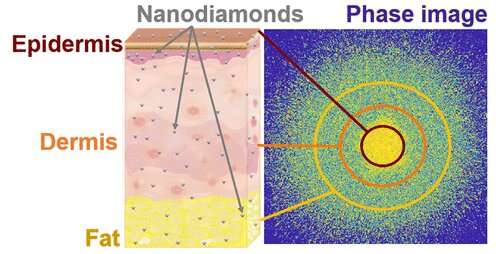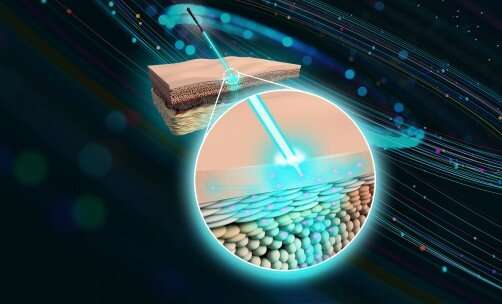Researchers produce nanodiamonds capable of delivering medicinal and cosmetic remedies through the skin

The skin is one of the largest and most accessible organs in the human body, but penetrating its deep layers for medicinal and cosmetic treatments still eludes science.
Although there are some remedies—such as nicotine patches to stop smoking—administered through the skin, this method of treatment is rare since the particles that penetrate must be no larger than 100 nanometers. Creating effective tools using such tiny particles is a great challenge. Because the particles are so small and difficult to see, it is equally challenging to determine their exact location inside the body—information necessary to ensure that they reach intended target tissue. Today such information is obtained through invasive, often painful, biopsies.
A novel approach, developed by researchers at Bar-Ilan University in Israel, provides an innovative solution to overcoming both of these challenges. Combining techniques in nanotechnology and optics, they produced tiny (nanometric) diamond particles so small that they are capable of penetrating skin to deliver medicinal and cosmetic remedies. In addition, they created a safe, laser-based optical method that quantifies nanodiamond penetration into the various layers of the skin and determines their location and concentration within body tissue in a non-invasive manner—eliminating the need for a biopsy.
This innovation was just published by researchers from the University's Institute of Nanotechnology and Advanced Materials, in cooperation with the Kofkin Faculty of Engineering and Department of Chemistry, in the scientific journal ACS Nano.
Nanodiamonds—a millionth of a millimeter in size—are produced by detonating explosives inside a closed chamber. Under these conditions high temperature and pressure cause the carbon atoms found in explosives to fuse together. The nanodiamonds created in the process are small enough to penetrate tissue—and even cells—without inflicting harm.

Nanodiamonds and drug delivery
Much like trucks that make deliveries, artificial diamonds can deliver various medications to intended targets, and their distance and location may be controlled due to the minute size of the nanodiamonds. The approach to drug delivery using nanoparticles has already proven successful in previous research.
The nanodiamonds newly developed at Bar-Ilan University have also been proven effective antioxidants. This property ensures that particles penetrating the body are both safe and therapeutic, as their chemical properties allow them to be coated with medication prior to their insertion into the body.
Tracking nanodiamonds through optics
The optical method developed by the research team enables them to identify relative nanodiamond concentrations of particles in the different layers of skin (epidermis, dermis and fat) through safe and non-invasive sensing based on a blue wavelength laser, a unique finding in itself given the fact that red wavelength lasers are generally used in human medical exams and treatments. To determine their location in the skin and in what concentration, patients are briefly exposed to the blue laser beam. An optical system creates a photograph-like 3D image through which optical changes in treated tissue can be extracted and compared to adjacent, untreated tissue using a specially-created algorithm.
"This is a significant development in dermatology and in optical engineering," says Prof. Dror Fixler, Director of the Institute of Nanotechnology and Advanced Materials at Bar-Ilan University and a member of the research team. "It could open the door to developing drugs applied through the skin alongside modern cosmetic preparations using advanced nanotechnology." Fixler's research, assisted by researcher Channa Shapira and others, demonstrates the importance of optical innovation in clinical application.
More information: Channa Shapira et al, Noninvasive Nanodiamond Skin Permeation Profiling Using a Phase Analysis Method: Ex Vivo Experiments, ACS Nano (2022). DOI: 10.1021/acsnano.2c03613
Journal information: ACS Nano
Provided by Bar-Ilan University




















